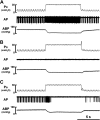Inhibitory effect of sulfur dioxide inhalation on Hering-Breuer inflation reflex in mice: role of voltage-gated potassium channels
- PMID: 36958348
- PMCID: PMC10125024
- DOI: 10.1152/japplphysiol.00714.2022
Inhibitory effect of sulfur dioxide inhalation on Hering-Breuer inflation reflex in mice: role of voltage-gated potassium channels
Abstract
Slowly adapting receptors (SARs), vagal mechanosensitive receptors located in the lung, play an important role in regulating the breathing pattern and Hering-Breuer inflation reflex (HBIR). Inhalation of high concentration of sulfur dioxide (SO2), a common environmental and occupational air pollutant, has been shown to selectively block the SAR activity in rabbits, but the mechanism underlying this inhibitory effect remained a mystery. We carried out this study to determine if inhalation of SO2 can inhibit the HBIR and change the eupneic breathing pattern, and to investigate further a possible involvement of voltage-gated K+ channels in the inhibitory effect of SO2 on these vagal reflex-mediated responses. Our results showed 1) inhalation of SO2 (600 ppm; 8 min) consistently abolished both the phasic activity of SARs and their response to lung inflation in anesthetized, artificially ventilated mice, 2) inhalation of SO2 generated a distinct inhibitory effect on the HBIR and induced slow deep breathing in anesthetized, spontaneously breathing mice, and these effects were reversible and reproducible in the same animals, 3) This inhibitory effect of SO2 was blocked by pretreatment with 4-aminopyridine (4-AP), a nonselective blocker of voltage-gated K+ channel, and unaffected by pretreatment with its vehicle. In conclusion, this study suggests that this inhibitory effect on the baseline breathing pattern and the HBIR response was primarily mediated through the SO2-induced activation of voltage-gated K+ channels located in the vagal bronchopulmonary SAR neurons.NEW & NOTEWORTHY This study demonstrated that inhaled sulfur dioxide completely and reversibly abolished the activity of vagal bronchopulmonary slowly adapting receptors, significantly inhibited the apneic response to lung inflation, and induced slow deep breathing in anesthetized mice. More importantly, our results further suggested that this inhibitory effect was mediated through an action of sulfur dioxide and its derivatives on the voltage-gated potassium channels expressed in the slowly adapting receptor sensory neurons innervating the lung.
Keywords: 4-aminopyridine; air pollutant; breathing pattern; lung; slowly adapting receptor; vagus nerve.
Conflict of interest statement
No conflicts of interest, financial or otherwise, are declared by the authors.
Figures






References
-
- Coleridge HM, Coleridge JCG. Reflexes evoked from tracheobronchial tree and lungs. In: Handbook of Physiology, The Respiratory System, Control of Breathing, edited by Cherniack NS, Widdicombe JG.. Bethesda, MD: American Physiological Society, 1986, p. 395–429. doi:10.1002/CPHY.CP030212. - DOI
Publication types
MeSH terms
Substances
Grants and funding
LinkOut - more resources
Full Text Sources
Miscellaneous

